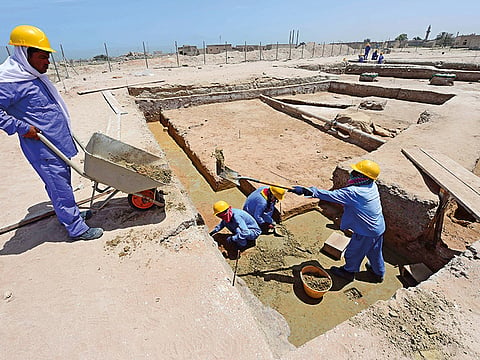UAE’s archeological research gives insight into a rich past
Presentations by archaeologists in Abu Dhabi detail country’s most interesting archeological findings

Abu Dhabi: Thanks to the encouragement of the late Shaikh Zayed Bin Sultan Al Nahyan, the founding father of the UAE, and his interest on preserving and learning about history, archeologists supported by the late ruler have discovered a treasure trove of history in the UAE dating back to more than 8,000 years ago.
The details of the UAE’s archaeological story were presented by two prominent UAE-based archeologists, Peter Magee, head of the archaeology department, coastal heritage and palaeontology, Abu Dhabi Tourism and Culture Authority, and Eisa Yousuf, director of excavation and archeological sites, Sharjah Archaeology Authority, during a public talk held recently in Abu Dhabi.
The presentations took the audience on a journey that began during the 1950s, before the formation of the UAE itself, when international archeologists from Denmark were invited to Abu Dhabi to carry out excavation works on Umm Al Nar Island.
“It was that mutual respect and encouragement from Shaikh Zayed which meant that archeological research in this country had a different spark [and] different meaning, which I believe fundamentally altered the trajectory of research and outcomes,” said Magee, who praised the openness of the UAE’s leaders for allowing international teams to come to the country and unearth its archaeological sites.
Detailing some of the discoveries that were made from the earliest excavation works, Magee said that tombs dating all the way back to 3000 BC were uncovered.
“They excavated at Jabel Hafeet; Shaikh Zayed was very interested in the mounds of rubble that he saw there, and in 1959 he asked them to come and investigate. So they excavated [and found] these Bronze Age tombs dated 3000 to 2500 BC.
“It cannot be emphasised enough that up until this time, up until they published their results in a Danish journal … There was no appreciation that this region had a prehistoric past,” he added, signifying the historical value of those early findings.
Continued excavations unravelled even more discoveries according to Magee, including living settlements.
“They also excavated in Umm Al Nar … Discovering the archetypal Umm Al Nar tombs dated back to 2500 BC,” he said. “In Al Ain, they actually discovered settlements at Hili one — they discovered a large fortress and a building which date back to about 2500 BC,” he added.
“These discoveries indicated that from around 3000 BC onwards, the UAE was engaged in trade, engaged in industry … And also the excavations at Hili one indicated that there were sedimentary settlements probably utilising in some way [the] agriculture,” he said.
Teams of international archaeologists continued to come to the country after the original team of Danes, according to Magee, unearthing even more fascinating facts about the ancient history of the UAE.
“Very recent excavations at the site of Marawah … revealed an incredibly early date evidence of maritime trade,” he said. “Artefacts [from Marawah] indicated that the people in this region were engaging in maritime trade 8,000 years ago. So 8,000 years ago, they were building ships, they had ship technology which allowed them to move across the Arabian Gulf, trade with areas within the Arabian Peninsula and trade also with Mesopotamia itself.”
Magee said that similar discoveries were also made in another area of the country in Tell Abraq.
“Excavations from the site of Tell Abraq indicated extensive maritime trade that existed around 2500 BC. The trade linked the UAE with Bahrain, Mesopotamia, Iran, Balochistan, and South Asia.
“The people who did this were able to harness the Indian Ocean monsoon winds [to travel to South Asia],” he added highlighting the innovative ingenuity possessed by the people of the region.
Magee went on to give more examples of innovations that were discovered by the excavation studies, including findings that showed that the earliest falaj (underground water channel) systems were created by the ancient inhabitants of today’s Al Ain.
“These excavations revealed the earliest dated falaj system yet discovered in the world. Similar excavations in Sharjah have revealed a similar dated falaj system [of 1000 BC].
“These discoveries are fundamentally important … Because they shed light on ancient innovation and adaptation … We can definitely say that the earliest evidence for the development of this system is found in the UAE,” he added.
For his part, Yousuf discussed other excavations carried out by international teams in Maliha which unearthed new and ancient historical sites.
“In Maliha, all discovered tombs had no human skulls … The tombs had specific designs, and they dated back to the third century BC.
“Other excavations found the skulls of boys buried inside a residential building in Maliha. Two boys were buried inside, and through carbonated dating, [it was discovered that] the skulls go back to 34 BC; these skulls are the only human evidence we have found in Maliha,” he added.
Echoing the sentiments of Magee, Yousuf paid homage to the late Shaikh Zayed for his crucial support in facilitating the archeological discoveries that were made around the UAE.
“When we talk about archaeology [in the UAE], we can see the first legislation in the UAE was made before the UAE was even established, when Shaikh Zayed issued a law on archaeology.”
Sign up for the Daily Briefing
Get the latest news and updates straight to your inbox



